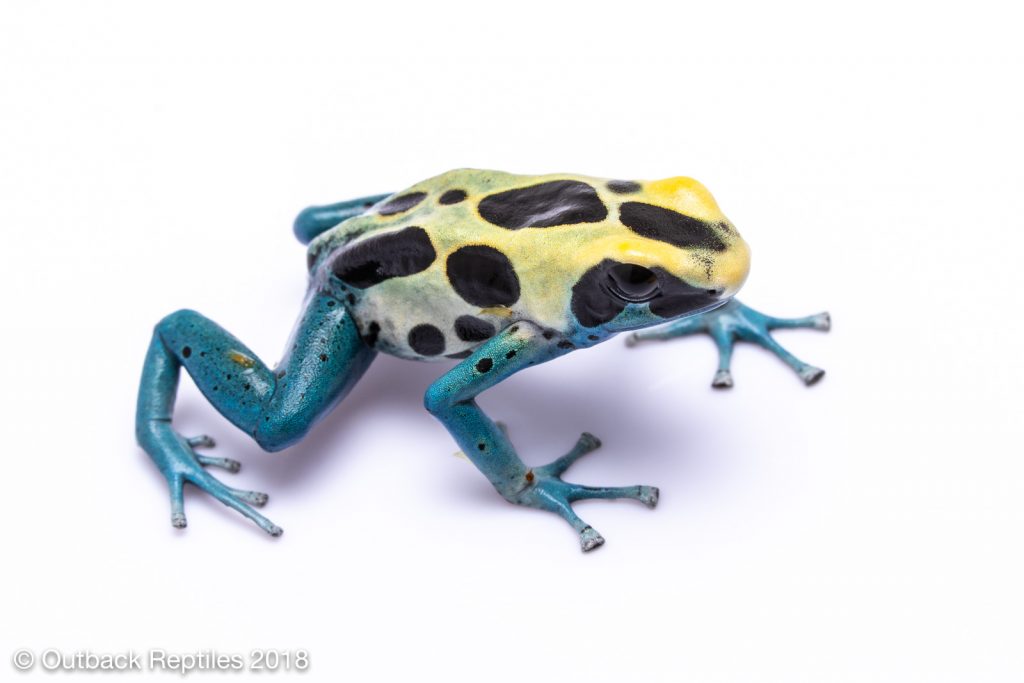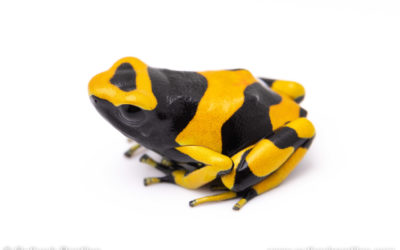Poison dart frogs are small, brightly colored amphibians that are popular as exotic pets. These fascinating creatures require special care to thrive in captivity. Here’s a guide to help you provide the best possible poison dart frog care:
Poison Dart Frog Enclosure
Poison dart frogs are tropical creatures that require specific habitat conditions to thrive in captivity. Providing an appropriate habitat is essential for the health and wellbeing of your pet frog. Here are the habitat requirements for poison dart frogs:
- Terrarium Size: The size of the terrarium depends on the species of poison dart frog. A good rule of thumb is to provide at least 10 gallons of space per frog. We recommend terrariums with mostly enclosed lids to hold in humidity, with just a few small air holes to aid in ventilation.
- Temperature: Poison dart frogs require a warm environment with temperatures between 70-80°F. It’s important to maintain a consistent temperature throughout the day and night.
- Humidity: These frogs require a high level of humidity, around 80%. Maintain the humidity by misting the terrarium with water regularly.
- Decorations: Provide plenty of hiding spots and climbing surfaces for your pet frog. Live plants and branches make great decorations for poison dart frog habitats.
Substrate
Choosing the right substrate for your poison dart frog’s habitat is important for their health and wellbeing. We recommend a drainage layer of gravel or aquaponics clay balls, followed by a damp substrate such as Sphagnum moss. This substrate retains moisture well and provides a good foothold for the frogs. It can be mixed with other substrates for added moisture retention. Avoid: Sand, exposed gravel, and other rough substrates as these can be harmful to poison dart frogs and may dry them out.
Lighting
Poison dart frogs require a UVB light source to help them metabolize calcium and maintain healthy bones. Here are the lighting requirements for poison dart frogs:
- UVB Light: Provide a UVB light source for 10-12 hours per day. Be sure to choose a light that’s appropriate for the size of your terrarium.
- Avoid: Heat lamps or incandescent bulbs, as this can cause overheating and dehydration, which could harm your pet frog.

Feeding
Poison dart frogs require a diet of live insects, such as fruit flies, crickets, and springtails. Here are the feeding requirements for poison dart frogs:
- Live Insects: Provide live insects for your pet frog every 2-3 days. Be sure to choose appropriately sized insects for your frog’s size.
- Variety: Offer a variety of insects to provide a balanced diet for your pet frog. Avoid feeding wild-caught insects, as they can contain harmful pesticides.
- Gut Load: Feed the insects a nutritious diet before feeding them to your pet frog. This will provide added nutrition for your pet frog.
Water
Providing clean, fresh water is important for the health and wellbeing of your poison dart frog. Here are the water requirements for poison dart frogs:
- Water Dish: Provide a shallow water dish for your pet frog to soak in. Change the water regularly to keep it clean.
- Alternatively, you can form the features of the cage in such a way as to leave an exposed “pool” area underneath in the drainage layer.
- Mist: Mist the terrarium regularly to maintain high levels of humidity. This will also provide water for your pet frog to drink.
Handling
Poison dart frogs are delicate creatures that should not be handled unless necessary. Here are some tips for handling your pet frog should the need arise (such as during cage cleaning or transfers):
- Wash your hands before handling your pet frog to avoid transferring oils or chemicals onto their skin.
- Handle your pet frog gently to avoid injuring them.
- If you need to move your pet frog, use a plastic container
We hope this guide has given you the basics and that your pet dart frogs will thrive! Providing proper care for your poison dart frog is essential for their health and wellbeing. By following the guidelines outlined in this care guide, you can ensure that your pet frog is living in a comfortable, safe, and healthy environment. From habitat requirements to feeding and handling, each aspect of caring for your poison dart frog is crucial. By taking the time to learn about your pet frog’s needs and providing the best possible care, you can enjoy many happy years with your fascinating and beautiful amphibian companion.

